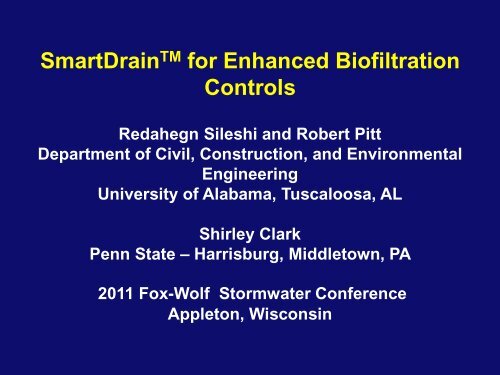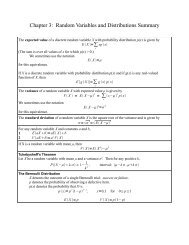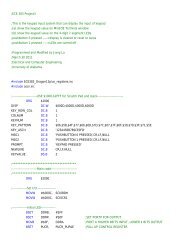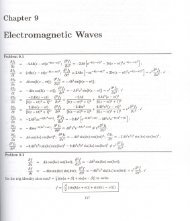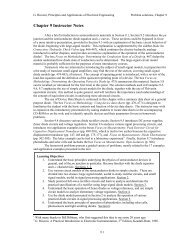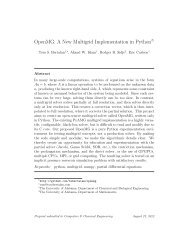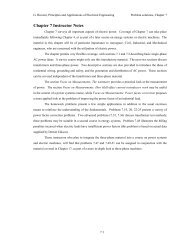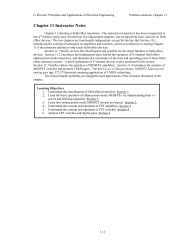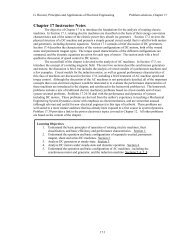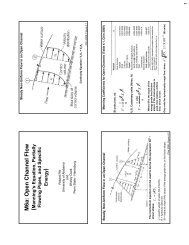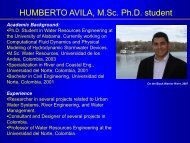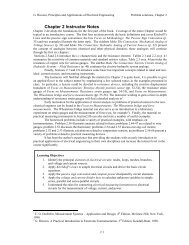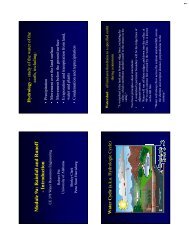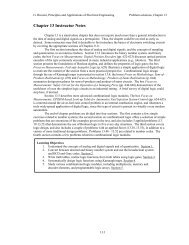SmartDrainTM for Enhanced Biofiltration Controls - Unix.eng.ua.edu
SmartDrainTM for Enhanced Biofiltration Controls - Unix.eng.ua.edu
SmartDrainTM for Enhanced Biofiltration Controls - Unix.eng.ua.edu
Create successful ePaper yourself
Turn your PDF publications into a flip-book with our unique Google optimized e-Paper software.
SmartDrain TM <strong>for</strong> <strong>Enhanced</strong> <strong>Biofiltration</strong><br />
<strong>Controls</strong><br />
Redahegn Sileshi and Robert Pitt<br />
Department of Civil, Construction, and Environmental<br />
Engineering<br />
University of Alabama, Tuscaloosa, AL<br />
Shirley Clark<br />
Penn State – Harrisburg, Middletown, PA<br />
2011 Fox-Wolf Stormwater Conference<br />
Appleton, Wisconsin
Outline of Presentation Topics<br />
• Green Infrastructure case study <strong>for</strong> CSO control<br />
relying on biofiltration systems in Kansas City,<br />
MO<br />
• <strong>Biofiltration</strong> media tests to optimize toxicant<br />
control <strong>for</strong> Southern Cali<strong>for</strong>nia industrial site<br />
having numeric stormwater limits<br />
• Residence time issues in biofiltration device<br />
designs<br />
• The use of the SmartDrain TM as a biofilter outlet<br />
control having slow drainage rates to enhance<br />
residence time and contaminant removal.
Kansas City’s CSO Chall<strong>eng</strong>e<br />
• Combined sewer area: 58 mi 2<br />
• Fully developed<br />
• Rainfall: 37 in./yr<br />
• 36 sewer overflows/yr by rain > 0.6 in; r<strong>edu</strong>ce<br />
frequency by 65%.<br />
• 6.4 billion gal overflow/yr, r<strong>edu</strong>ce to 1.4 billion<br />
gal/yr<br />
• Aging wastewater infrastructure<br />
• Sewer backups<br />
• Poor receiving-water q<strong>ua</strong>lity
Kansas City’s<br />
Original<br />
Middle Blue<br />
River Plan<br />
with CSO<br />
Storage Tanks<br />
1/26/2009
Adjacent Test and Control Watersheds
KC’s Modeling Connections<br />
SUSTAIN-SWMM<br />
- Individ<strong>ua</strong>l LID<br />
- Drainage (Transport)<br />
- Multi-scale<br />
- Subarea Optimization<br />
Weight of<br />
Evidence<br />
KCMO XP-SWMM<br />
- Drainage (Transport)<br />
- Design Objectives<br />
WinSLAMM<br />
-Land Surface Characteristics<br />
-Drainage (Transport)<br />
-Design Options<br />
-Stormwater Beneficial Uses<br />
- Multi-scale
Examples from “65%” plans prepared<br />
by URS <strong>for</strong> project streets. Plans<br />
reviewed and modeled by project team,<br />
and construction of several hundred<br />
biofilter systems will occur in spring<br />
and summer of 2011.
R<strong>edu</strong>ctions in Ann<strong>ua</strong>l Flow Q<strong>ua</strong>ntity from Directly<br />
Connected Roofs with the use of Rain Gardens<br />
(Kansas City CSO Study Area)<br />
Percent r<strong>edu</strong>ction in ann<strong>ua</strong>l roof runoff<br />
100<br />
90<br />
80<br />
70<br />
60<br />
50<br />
40<br />
30<br />
20<br />
10<br />
0<br />
0.1 1 10 100<br />
Percent of roof area as rain garden
Ann<strong>ua</strong>l Runoff R<strong>edu</strong>ctions from Paved Areas <strong>for</strong><br />
Different Sized Biofilters <strong>for</strong> Various Soils<br />
R<strong>edu</strong>ction in Ann<strong>ua</strong>l Impervious<br />
Area Runoff (%)<br />
100<br />
10<br />
clay (0.02 in/hr)<br />
silt loam (0.3 in/hr)<br />
sandy loam (1 in/hr)<br />
1<br />
0.1 1 10 100<br />
Biofilter Size (% of drainage area)
Clogging Potential <strong>for</strong> Different Sized Rain<br />
Gardens Receiving Roof Runoff<br />
10000<br />
Years to Clogging<br />
1000<br />
100<br />
10<br />
years to 10 kg/m2<br />
years to 25 kg/m2<br />
1<br />
0.1 1 10 100<br />
Rain Garden Size (% of roof area)<br />
Clogging not likely a problem <strong>for</strong> rain gardens receiving roof<br />
runoff
Clogging Potential <strong>for</strong> Different Sized Biofilters<br />
Receiving Paved Parking Area Runoff<br />
1000<br />
Years to Clogging<br />
100<br />
10<br />
1<br />
0.1 1 10 100<br />
Biofilter Size (% of paved parking area)<br />
years to 10 kg/m2<br />
years to 25 kg/m2<br />
Biofilters should be at least 10% of the paved drainage area, or<br />
receive significant pre-treatment (such as with long grass filters or<br />
swales, or media filters) to prevent premature clogging.
Engineered Bioretention Media <strong>for</strong><br />
Industrial Stormwater Treatment
• Goals:<br />
Media Testing<br />
– To provide in<strong>for</strong>mation <strong>for</strong> design (e.g., optimal<br />
media components, depths, and contact times)<br />
– To maximize the likelihood that filtration-based<br />
treatment controls will achieve desired level of<br />
per<strong>for</strong>mance in the most cost effective manner<br />
14<br />
These tests were conducted in conjunction with Dr. Shirley Clark at Penn State – Harrisburg<br />
and Geosystec, and sponsored by The Boeing Co.
Media Tests (cont’d)<br />
• Long-Term Column tests using act<strong>ua</strong>l stormwater:<br />
– Clogging, breakthrough, and removal<br />
– Effects of contact time and media depth on removal<br />
• Batch tests:<br />
– Media uptake capacity and removal kinetics<br />
– Aerobic and anaerobic effects on pollutant mass<br />
removed<br />
15
layered S-Z-GAC<br />
R-SMZ-GAC-PM<br />
Granular activated<br />
carbon (GAC)<br />
20<br />
15<br />
10<br />
5<br />
Peat moss (PM)<br />
Rhyolite sand ( R)<br />
Maintenance with scraping<br />
of the surface of the media<br />
was not very effective; the<br />
removal of several inches of<br />
media worked better, but<br />
still only <strong>for</strong> a limited time.<br />
0<br />
R-SMZ-GAC<br />
Surface modified<br />
zeolite (SMZ)<br />
R-SMZ<br />
Site zeolite (Z)<br />
load to initial maintenance<br />
(kg/m2)<br />
Site sand (S)<br />
initial average flow rate (m/day)<br />
1. Site sand clogged first and had the lowest flow rate<br />
2. Site zeolite and peat alone were next to clog<br />
3. <strong>Biofiltration</strong> mixed media combination per<strong>for</strong>med better than current site<br />
layered media combination Pitt and Clark 2010
Long-Term Column Test Results:<br />
Pollutant Removal<br />
Site Sand<br />
Peat moss<br />
GAC<br />
Peat moss<br />
GAC<br />
• Of individ<strong>ua</strong>l media types studied, peat and GAC demonstrated best removal<br />
<strong>for</strong> total and dissolved copper (although note the relatively high influent<br />
concentrations)<br />
• Primary copper removal mechanism appears to be physical straining (of<br />
particulate-associated phase) and sorption onto GAC along with organic<br />
complexation with peat components, rather than cation exchange
Column Test Results: Pollutant Removal<br />
(paired sign test of influent vs. effluent)<br />
Media<br />
Type<br />
R-SMZ-<br />
GAC<br />
S-Z-GAC<br />
(layered)<br />
Cr, Cu,<br />
Sb, Al<br />
Pb Zn Cd, Ni,<br />
Tl, Fe<br />
Hg NO 3 TCDD<br />
T, F T T T, F T T T<br />
Recommended<br />
biofiltration mixed<br />
media combination<br />
T, F T T, F T T T Layered filter media<br />
combination<br />
currently in use<br />
R = rhyolite; SMZ = surface modified zeolite; GAC = granular activated carbon; PM = peat moss; S = site sand; Z = site zeolite<br />
T = removal <strong>for</strong> total <strong>for</strong>m (unfiltered); F = removal <strong>for</strong> filtered <strong>for</strong>m (passed through 0.45-µm membrane filter)<br />
Other findings (data not shown here):<br />
• The bioretention media combination met all current site permit limits, except<br />
<strong>for</strong> copper and mercury during peak conditions (not expected to occur), and<br />
had significant removals <strong>for</strong> all constituents measured, except <strong>for</strong><br />
phosphorus and gross beta radioactivity.<br />
• The current site layered media combination resulted in all effluent samples<br />
meeting the current site permit limits, except <strong>for</strong> a slightly elevated pH,<br />
when maximum site runoff conditions were considered.
Media Per<strong>for</strong>mance Plots <strong>for</strong> Copper, Full-Depth<br />
Long-Term Column Tests<br />
14 µg/L limit
This image cannot currently be displayed.<br />
This image cannot currently be displayed.<br />
Probability Plot of Influent 0.45~3 µm, GAC 0.45~3 µm<br />
Normal - 95% CI<br />
Percent<br />
99<br />
95<br />
90<br />
80<br />
70<br />
60<br />
50<br />
40<br />
30<br />
20<br />
Variable<br />
Influent 0.45~3 µm<br />
GAC 0.45~3 µm<br />
Mean StDev N AD P<br />
9.850 7.242 7 0.484 0.150<br />
3.276 2.040 7 0.294 0.503<br />
10<br />
5<br />
1<br />
-20<br />
-10<br />
0<br />
10<br />
Data<br />
20<br />
30<br />
40<br />
Probability Plot of Influent 12~30 µm, GAC 12~30 µm<br />
Normal - 95% CI<br />
Percent<br />
99<br />
95<br />
90<br />
80<br />
70<br />
60<br />
50<br />
40<br />
30<br />
20<br />
Variable<br />
Influent 12~30 µm<br />
GAC 12~30 µm<br />
Mean StDev N AD P<br />
54.47 25.49 7 0.156 0.917<br />
0.6159 0.3258 7 0.273 0.544<br />
10<br />
5<br />
1<br />
-50<br />
0<br />
50<br />
Data<br />
100<br />
150<br />
All media were very effective <strong>for</strong> the removal of a wide range of<br />
20<br />
particle sizes
Breakthrough Capacity Compared to<br />
Clogging Period<br />
Ratios of Media<br />
Capacity to<br />
Clogging Period<br />
R-SMZ<br />
R-SMZ-<br />
GAC<br />
R-SMZ-<br />
GAC-PM<br />
Site Sand-<br />
GAC-Site<br />
Zeolite<br />
Layered<br />
Cadmium, Total >230 >170 >130 >150<br />
Copper, Total >2.2 >3.4 >1.7 >2.2<br />
Gross Alpha<br />
radioactivity >0.3 >0.3 >0.2 >0.2<br />
Lead, Total >2.1 >1.6 >0.9 >0.9<br />
Mercury >250 >230 >130 >140<br />
Oil and Grease 0.1 >0.1 >0.1 3.1 >2.5 >1.3 >1.5<br />
Green: will clog be<strong>for</strong>e breakthrough<br />
Red: breakthrough be<strong>for</strong>e clogging
Cumulative Particulate Loading to Failure and Expected<br />
Years of Operation <strong>for</strong> Largest Sedimentation-<strong>Biofiltration</strong><br />
Treatment Trains on Project Site<br />
R-SMZ<br />
R-SMZ-<br />
GAC<br />
R-SMZ-<br />
GAC-PM<br />
Site Sand-GAC-Site<br />
Zeolite Layered<br />
Load to clogging<br />
(kg/m 2 ) 7.5 - 38 11 - 53 11 - 55 6.5 - 33<br />
Years to<br />
replacement 12 - 58 16 - 81 17 - 84 10 - 50<br />
• Seven of the site biofilters were eval<strong>ua</strong>ted <strong>for</strong> clogging potential and<br />
chemical removal capacity. The biofilters were from about 1 to 10% of<br />
the drainage areas in size and had sedimentation pre-treatment.<br />
• All of the media combinations would likely have an operational life of<br />
at least 10 years <strong>for</strong> the constituents of greatest concern, with the<br />
exception of oil and grease <strong>for</strong> the layered media.
Batch Testing Results: Contact Time<br />
Minimal filtered<br />
metal removal<br />
observed <strong>for</strong> all<br />
media except peat<br />
when contact time<br />
Varying Depth Column Test Results<br />
• These tests determined the effect of contact time on pollutant<br />
removal. Longer contact times should enhance pollutant removals<br />
because the likelihood of making a favorable contact with the media<br />
increases.<br />
• Only the GAC showed good removals of nitrate, with the removal<br />
ability being best with the deepest column. GAC there<strong>for</strong>e has a<br />
limited capacity <strong>for</strong> nitrate and increasing the amount of GAC in<br />
contact with the passing influent water increases the l<strong>eng</strong>th of time<br />
that excellent removals occur.
Example Relationship between Media<br />
Depth and Contact Time<br />
Typical Contact Time (minutes)<br />
14<br />
12<br />
10<br />
8<br />
6<br />
4<br />
2<br />
0<br />
Rhyolite Sand, Surface Modified Zeolite,<br />
and Granular Activated Carbon Mix<br />
0 5 10 15 20 25 30 35 40<br />
Media Depth (inches)
Contaminant Losses during Anaerobic vs. Aerobic<br />
Conditions between Events<br />
Stripping of COD was more severe during anaerobic conditions (also nutrient losses under<br />
anaerobic conditions; metals relatively stable)
Preparing Recommended Media <strong>for</strong> Large Biofilters<br />
1. Filling<br />
individ<strong>ua</strong>l<br />
media bags<br />
prior to<br />
mixing<br />
2. Loading<br />
Rhyolite<br />
sand media<br />
bags into<br />
mixer<br />
3. Loading<br />
surface<br />
modified<br />
zeolite media<br />
bags into mixer<br />
5. Finished<br />
mixed media<br />
loaded into<br />
final bags<br />
4. Loading<br />
granular<br />
activated<br />
carbon media<br />
bags into mixer<br />
6. Mixed<br />
media ready<br />
<strong>for</strong> placement<br />
into biofilters
Many Areas Require Biofilter Drainage within<br />
72 hours to Prevent Mosquito Infestation
Underdrain Effects on Water<br />
Balance<br />
0.75 inch rain with complex inflow<br />
hydrograph from 1 acre of pavement.<br />
2.2% of paved area is biofilter surface,<br />
with natural loam soil (0.5 in/hr infilt. rate)<br />
and 2 ft. of modified fill soil <strong>for</strong> water<br />
treatment and to protect groundwater.<br />
No Underdrain<br />
78% runoff volume r<strong>edu</strong>ction<br />
77% part. solids r<strong>edu</strong>ction<br />
31% peak flow rate r<strong>edu</strong>ction<br />
76% runoff volume r<strong>edu</strong>ction <strong>for</strong> complete<br />
1999 LAX rain year<br />
74% part. solids r<strong>edu</strong>ction <strong>for</strong> complete 1999<br />
LAX rain year<br />
Conventional (per<strong>for</strong>ated<br />
pipe) Underdrain<br />
33% runoff volume r<strong>edu</strong>ction<br />
85% part. solids r<strong>edu</strong>ction<br />
7% peak flow rate r<strong>edu</strong>ction<br />
Restricted Underdrain<br />
49% runoff volume r<strong>edu</strong>ction<br />
91% part solids r<strong>edu</strong>ction<br />
80% peak flow rate r<strong>edu</strong>ction
• Outlet control can be more consistent in providing desired<br />
resident time <strong>for</strong> pollutant control.<br />
• However, most outlet controls (underdrains) are difficult to<br />
size to obtain long residence times.<br />
• Per<strong>for</strong>ated pipe underdrains short-circuit natural<br />
infiltration, resulting in decreased per<strong>for</strong>mance.<br />
• Orifice outlet controls that allow long residence times<br />
us<strong>ua</strong>lly are very small and clog easily.<br />
• We are studying a foundation drain material (SmartDrain TM )<br />
that can be applied to biofiltration devices and provide<br />
another option <strong>for</strong> outlet control.
SmartDrain TM (http://www.smartdrain.com/)<br />
• SmartDrain TM operates<br />
under laminar flow<br />
conditions (Reynolds<br />
number of 100 to 600); low<br />
sediment carrying capacity<br />
and r<strong>edu</strong>ced clogging<br />
potential.<br />
• SmartDrain TM has132<br />
micro channels in an 8<br />
inch wide strip; results in<br />
very small discharge rates.<br />
Close-up photograph of SmartDrain TM<br />
material showing the microchannels on<br />
the underside of the 8 inch wide strip.
Variables affecting the drainage<br />
characteristics of the underdrain material<br />
A pilot-scale biofilter was<br />
used to test the variables<br />
affecting the drainage<br />
characteristics of the<br />
underdrain material:<br />
• L<strong>eng</strong>th<br />
• Slope<br />
• Hydraulic head<br />
• Type of sand media<br />
A fiberglass trough 10 ft long and 2 x 2ft in<br />
cross section used as the pilot-scale biofilter
Experimental proc<strong>edu</strong>re<br />
• The SmartDrain TM was<br />
installed on top of a 4”<br />
layer of the drainage sand,<br />
and another 4” layer of the<br />
sand was placed on top of<br />
the SmartDrain TM .<br />
• Flow rate measurements<br />
were man<strong>ua</strong>lly taken from<br />
the effluent of the biofilter<br />
at 25 to 30 minute intervals<br />
until the water was<br />
completely drained from<br />
the trough.<br />
SmartDrain TM installation In the drainage<br />
sand (it was unrolled be<strong>for</strong>e placement of<br />
the cover sand).
Experimental proc<strong>edu</strong>re Cont.<br />
• During the tests, the<br />
trough was initially filled<br />
with water to a<br />
maximum head of 22<br />
inches above the<br />
center of the pipe and<br />
then allowed to drain,<br />
resulting in head vs.<br />
discharge data.<br />
• A hydraulic jack and<br />
blocks were used to<br />
change the slope of the<br />
tank.<br />
test <strong>for</strong> effect of l<strong>eng</strong>th and slope on the<br />
drainage characteristics of SmartDrain TM<br />
material
Experimental proc<strong>edu</strong>re Cont.<br />
• The flows were<br />
measured by timing<br />
how long it took to fill<br />
a 0.5 L grad<strong>ua</strong>ted<br />
cylinder.<br />
• Five replicates <strong>for</strong> each<br />
of five different l<strong>eng</strong>ths<br />
of the SmartDrain TM<br />
(9.4ft, 7.1ft, 5.1ft, 3.1ft,<br />
and 1.1ft) and three to<br />
five slopes were<br />
examined to study the<br />
variables affecting the<br />
drainage characteristics<br />
of the material.<br />
Flow rate measurement from effluent of the<br />
biofilter
Slope tests on the SmartDrain TM material.<br />
Flow rate (L/s) = 0.13 (head, m) – 0.0049
Flow rate (L/s) = 0.12 (head, m) – 0.0036<br />
Slope of the SmartDrain TM material had no significant effect on the stage-discharge<br />
relationship, whereas only a small effect of l<strong>eng</strong>th of the SmartDrain TM material on<br />
the discharge was observed (operates similar to a series of very small orifices).<br />
• 0.51054 0.51054 0.51054 0.51054 0.51054 0.51054 0.4826 0.46736 0.4826 0.46736 0.4826 0.46736 0.43942 0.4191 0.43942 0.4191 0.43942 0.4191 0.39878 0.37338 0.39878 0.37338 0.39878 0.37338 0.3556 0.33782 0.3556 0.33782 0.3556 0.33782 0.15748<br />
0.2667 0.15748 0.2667 0.15748 0.2667 0.0762 0.1143 0.0762 0.1143 0.0762 0.1143 0.04445 0.0762 0.04445 0.0762 0.04445 0.0762 0.0254 0.05715 0.0254 0.05715 0.0254 0.05715 0.01778 0.04826 0.01778 0.04826 0.01778 0.04826 0.04445 0.04445 0.04445
Examining the clogging potential of the<br />
SmartDrain TM .<br />
• A Formica-lined plywood box was<br />
used to verify the head vs. discharge<br />
relationships <strong>for</strong> deeper water and<br />
used <strong>for</strong> the clogging tests.<br />
• The SmartDrain TM was installed on<br />
top of a 4” layer of the drainage<br />
sand, and another 4” layer of the<br />
sand was placed on top of the<br />
SmartDrain TM .<br />
• The box was filled with tap water to<br />
produce a maximum head of 4ft<br />
above the filter.<br />
• Sil-Co-Sil 250 was mixed with the<br />
test water to provide a concentration<br />
of 1g/L (1,000 mg/L).<br />
Formica-lined plywood box 3ft by 2.8ft. in<br />
cross sectional area and 4ft tall.
Particle size distributions of the sand filter media, and the US Silica<br />
Sil-Co-Sil 250 ground silica material used in the clogging tests.<br />
Sil-Co-Sil 250<br />
test material<br />
(median size<br />
45 µm)<br />
Filter Sand (median<br />
size 700 µm)
Turbidity measurements taken from the effluent of the device during<br />
the clogging tests.<br />
The initial turbidity values in the tank were about 1,000 NTU, similar to the initial<br />
turbidity values in the treated water. However, these effluent values decreased<br />
significantly and rapidly during the drainage period, with most of the sediment<br />
remaining trapped in the tank on top of the filter sand.
Plot showing Sil-Co-Sil250 load(kg/m 2 ) vs. slope<br />
coefficients <strong>for</strong> the clogging tests.<br />
Very little r<strong>edu</strong>ction in flow rates observed with time, even after 40<br />
kg/m 2 load on the biofilter (2 to 4 times the typical clogging load)
Smart Drain Flow Rates Compared to Very Small Orifices<br />
0.14<br />
0.12<br />
Orifice<br />
0.25 inches<br />
0.1<br />
Orifice<br />
0.20 inches<br />
Flow rate (L/s)<br />
0.08<br />
0.06<br />
0.04<br />
Smart Drain<br />
1.1 to 9.4 ft<br />
clean water<br />
Smart Drain<br />
1.25 ft<br />
clean water<br />
Smart Drain<br />
1.25 ft<br />
dirty water<br />
0.02<br />
0<br />
0 0.2 0.4 0.6 0.8 1 1.2<br />
Head (m)<br />
Orifice<br />
0.1 inches
Typical biofilter as modeled in WinSLAMM <strong>for</strong> an area having poor soils.
Biofilter Underdrain Options and Water Balance<br />
• The sandy-silt loam soil results in extended surface ponding, requiring<br />
an underdrain (736 hours of rain per year; 44,500 ft 3 /acre discharged to<br />
biofilters per year).<br />
• Conventional underdrain (3 inch per<strong>for</strong>ated pipe) r<strong>edu</strong>ces ponding, but<br />
also decreases infiltration opportunities and decreases contact time with<br />
media.<br />
• SmartDrain TM also r<strong>edu</strong>ces ponding time, while providing additional<br />
infiltration and increased media contact time.<br />
Ann<strong>ua</strong>l runoff (ft 3 /acre/year) and percentage fate:<br />
Surface<br />
ponding<br />
(hrs/year)<br />
No<br />
underdrain 1,480<br />
Typical 3 inch<br />
underdrain 530<br />
SmartDrain TM 1,080<br />
Infiltration<br />
volume<br />
31,700<br />
(72%)<br />
17,200<br />
(39%)<br />
26,300<br />
(59%)<br />
Surface<br />
discharge<br />
12,800<br />
(28%)<br />
4,400<br />
(10%)<br />
10,500<br />
(23%)<br />
Subsurface<br />
(filtered)<br />
discharge<br />
0<br />
Surface<br />
discharge<br />
r<strong>edu</strong>ction (%)<br />
(0%) 72%<br />
22,900<br />
(51%) 38%<br />
7,800<br />
(18%) 58%
Biofouling Testing of SmartDrain TM Material<br />
• The Formica-lined plywood box was also used<br />
to verify the head vs. discharge relationships<br />
<strong>for</strong> the biofouling tests.<br />
• The SmartDrain TM was installed on top of a 4”<br />
layer of the drainage sand, and another 4”<br />
layer of the sand was placed on top of the<br />
SmartDrain TM .<br />
• The box was filled with tap water and left open<br />
to the sun <strong>for</strong> several weeks to promote the<br />
growth of algae. Two different species of algal<br />
and liquid fertilizer were added to the test<br />
water.<br />
growth of algae in the biofilter device
Biofouling Tests of SmartDrain TM Material<br />
Turbidity values in the tank after several weeks<br />
ranged from 6 to 39 NTU, whereas effluent<br />
values were r<strong>edu</strong>ced to 4 to 7 NTU during the<br />
drainage tests.
Turbidity (NTU) vs. Flowrate <strong>for</strong> the<br />
biofouling tests
Stage-discharge relationships <strong>for</strong> the biofouling tests were very<br />
similar to the Sil-Co-Sil clogging test results.<br />
0.16<br />
SmartDrain TM Biofouling Test Results (l<strong>eng</strong>th = 2.75 ft)<br />
(combined results <strong>for</strong> 4 tests)<br />
Flowrate (L/sec)<br />
0.14<br />
0.12<br />
0.1<br />
0.08<br />
0.06<br />
0.04<br />
y = 0.12x<br />
R 2 = 0.97<br />
0.02<br />
0<br />
0 0.2 0.4 0.6 0.8 1 1.2<br />
Head (m)
Conclusions<br />
• The slope of the SmartDrain TM material had no significant effect<br />
on the stage-discharge relationship, while the l<strong>eng</strong>th had only a<br />
small effect on the discharge rate.<br />
• Effluent turbidity (NTU) measurements decreased rapidly with<br />
time, indicating significant retention of silt in the test biofilter.<br />
• Clogging and biofouling of the SmartDrain TM material was<br />
minimal during extended tests.<br />
• Our tests indicate that the SmartDrain TM material provides an<br />
additional option <strong>for</strong> biofilters, having minimal clogging potential<br />
while also providing very low discharge rates which encourage<br />
infiltration and allow extended media contact periods, compared<br />
to typical underdrains.
Acknowledgements<br />
• The US EPA is supporting the Kansas City green<br />
infrastructure demonstration project (the<br />
University of Alabama is a subcontractor to<br />
TetraTech).<br />
• The Boeing Co. supported the recent biofilter<br />
media tests (Geosyntec and Penn State –<br />
Harrisburg provided much project assistance and<br />
support).<br />
• Many University of Alabama and Penn State –<br />
Harrisburg grad<strong>ua</strong>te students assisted in<br />
conducting these tests.


